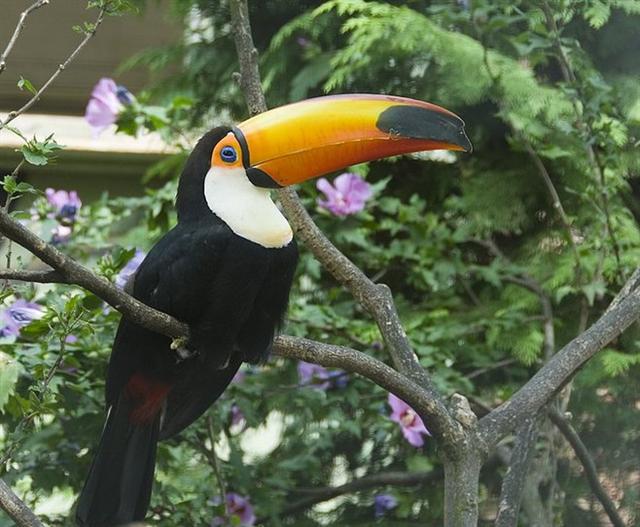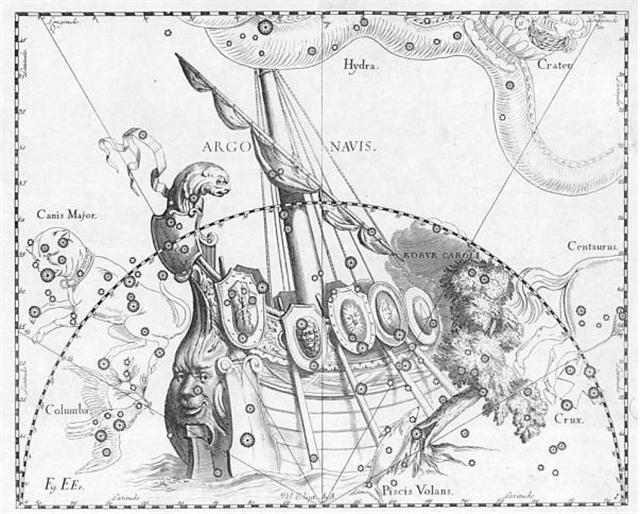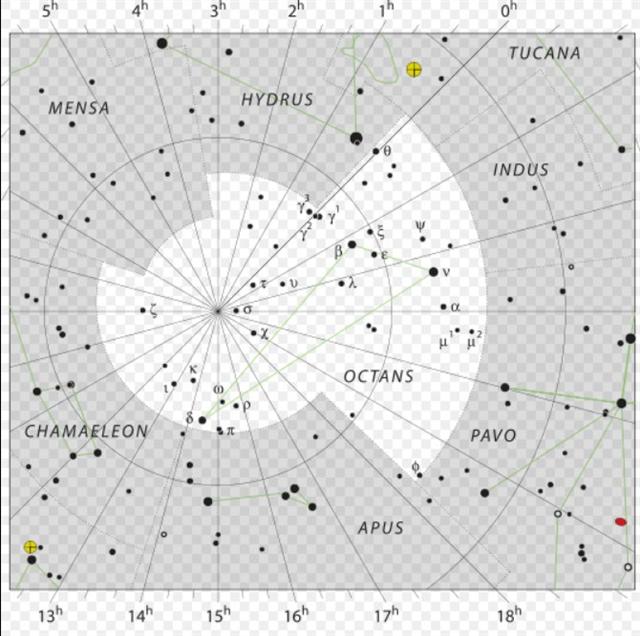This is the 'octopus' (Octans)
with σ close to the pole at
a right ascension somewhere between
21h and 22h:
The Hindus had the name Dramasa
for σ Octantis, according to
Allen. No explanation of what
the name means.
In my astronomy book are
mentioned also α, β, δ, ε, θ,
and ν. But there should be 8
stars and the γ triplet close to
0h is conspiciously missing.
Counting with the rest of the
Greek lettered stars in the map
above I
arrive at 21 (not counting more
than 1 star for γ and μ). I cannot find η,
ο, or ψ. However, in
Wikipedia the star list for Octans
contains also the 3 absent
ones.
My astronomy book says the
weak σ was not of much practical use for the
southern sailors. Instead they
observed stars in the Toucan.

The Magellanic
clouds and the Swordfish
(Dorado) were also used in their
navigation.

... After the neck of Oto Uta
had been brought on land, out in
the bay of Hanga Rau, the
wind, the rain, the waves, and
the thunder subsided. Kuihi
and Kuaha arrived and
told the king the following:
'King Oto Uta is out in
the bay of Hanga Rau'.
Hotu said to his servant (tuura)
Moa Kehu, 'Go down to
king Oto Uta and take him
up out of the bay of Hanga
Rau!' Moa Kehu arose,
went down, picked up (the
fragment), and carried (it) on
his shoulders to the house.
There he left it for King
Hotu. King Hotu sat
down and wept over King Oto
Uta. This is Hotu's
lament (tanginga):
ka hati toou ngao e oto uta e te
ariki e / mo tau papa rangaranga
o haho i te tai / mo tuu huehue
rangaranga o haho i te tai / mo
tau hahave rere ai ka pae / mo
tae ngu rere ai ka pae / mo te
ika aringa riva nei he aku renga
ai ka pae
Broken is your neck, oh Oto
Uta, oh king! / Floating (?)
like a raft (?) out at sea. / To
be erected for the drifting
huehue (fish) out at sea. /
Able (?) to put an end to the
flight of the flying fish
hahave; / Able (?) to put
and end to the flight of the
flying fish ngu; / Put an
end to this fish, a dorado, with
the good face! (E:87-90)
...
One of his pair of flying fishes
(hahave or ngu)
could possibly refer to the fish
Volans, strangely caught between
Argo Navis and the Tree:

The circumpolar
position of Octans means its
stars are distributed almost
around the whole of the right
ascension cycle:
|
γ╣ |
23h 52m 06.69s |
23h52.112m |
362.4 |
|
γ▓ |
23h 57m 32.99s |
23h57.550m |
363.8 |
|
θ |
00h
01m 35.85s |
00h01.598m |
0.4 |
|
γ│ |
00h
10m 02.27s |
00h10.378m |
1.8 |
|
ο |
00h
12m 33.96s |
00h12.566m |
2.3 |
|
ζ |
08h
56m 41.88s |
08h56.698m |
135.3 |
|
η |
10h
59m 14.16s |
10h59.236m |
166.4 |
|
ι |
12h
54m 58.35s |
12h54.973m |
195.8 |
|
κ |
13h
40m 56.18s |
13h40.936m |
207.4 |
|
δ |
14h
26m 56.74s |
14h26.946m |
219.1 |
|
π╣ |
15h
01m 50.70s |
15h01.845m |
227.9 |
|
π▓ |
15h
04m 46.96s |
15h04.783m |
228.7 |
|
ω |
15h
11m 08.79s |
15h11.147m |
230.3 |
|
ρ |
15h
43m 16.10s |
15h43.268m |
238.5 |
|
φ |
18h
23m 36.44s |
18h23.607m |
279.1 |
|
χ |
18h
54m 47.65s |
18h54.794m |
287.0 |
|
μ▓ |
20h
41m 43.74s |
20h41.729m |
314.2 |
|
μ╣ |
20h 42m 02.52s |
20h42.042m |
314.2 |
|
σ |
21h
08m 46.01s |
21h08.767m |
321.0 |
|
α |
21h 14m 43.03s |
21h14.717m |
322.5 |
|
ν |
21h
41m 28.47s |
21h41.475m |
329.3 |
|
λ |
21h
50m 54.25s |
21h50.904m |
331.7 |
|
Alnair |
22h 08m 13.88s |
22h08.231m |
336.1 |
|
ψ |
22h
17m 50.70s |
22h17.845m |
338.5 |
|
ε |
22h
20m 01.48s |
22h20.025m |
339.1 |
|
υ |
22h
31m 37.83s |
22h31.631m |
342.0 |
|
β |
22h 46m 03.72s |
22h46.062m |
345.7 |
|
ξ |
22h
50m 22.75s |
22h50.379m |
346.8 |
|
τ |
23h
28m 03.57s |
23h28.060m |
356.3 |
The
only
star
in
the
Octopus
which
possibly
could
have
been
relevant
in
line
Gb6
up
to
and
including
Ko
Ruti
6
(285)
was φ
-
i.e., given
an
uninterrupted
reading
from
Ga1-1:
 |
 |
 |
 |
 |
 |
|
Martius 6 |
7 |
8 (432) |
9 |
10 |
11 (70) |
|
Gb6-11 (393) |
Gb6-12 (165) |
Gb6-13 |
Gb6-14 |
Gb6-15 |
Gb6-16 |
|
APRIL 18 |
19 (*29) |
20 |
21 (111) |
22 |
23 (478) |
|
ξ Orionis (92.5) |
Al Han'ah-4 /
Maru-sha-pu-u-mash-mashu-8 |
Furud (94.9) |
Well-22 |
no star listed (96) |
β Monocerotis, ν
Gemini (97.0) |
|
TEJAT PRIOR
(93.4), γ
Monocerotis (93.5),
κ Aurigae (93.6), κ
Columbae (93.8) |
δ Columbae (95.2),
TEJAT POSTERIOR,
Mirzam (95.4),
CANOPUS (95.6), ε
Monocerotis (95.7),
ψ1 Aurigae (95.9) |
|
Solstice |
June 22 (173) |
23 |
St John's Eve |
25 |
26 |
|
5-25 |
'May 26 |
27 |
28 (*68) |
29 |
30 (150) |
|
"May 11 |
12 |
13 |
14 (*54) |
15 |
16 (136) |
|
NAKSHATRA DATES: |
|
OCTOBER 18 |
19 |
20 |
21 |
22 (295) |
23 (*216) |
|
ι Pavonis (275.1),
Polis (275.9)
Menkar
|
η Sagittarii
(276.9) |
Purva Ashadha-20 |
Kaus Borealis
(279.3) |
ν Pavonis (280.4), κ
Cor. Austr. (280.9) |
|
KAUS MEDIUS,
κ Lyrae (277.5),
Tung Hae (277.7) |
φ
Oct.
(278.1),
KAUS AUSTRALIS
(278.3), ξ Pavonis
(278.4), Al Athfar
(278.6) |
|
Solstice |
December 22 |
23 |
Christmas Eve |
25 |
26 (360) |
|
'November 24 |
25 (329) |
26 (*250) |
27 |
28 |
29 |
|
π |
"November 11 |
12 (*236) |
13 |
14 |
15 |
|
KO RUTI 1 (*200) |
2 |
3 |
4 |
5 |
6 (285) |
|
KO RUTI 6 |
7 |
8 |
9 |
*204 = *279 - *75 |
11 (285) |
|
Egyptian bread,
(-t,
female
determinant) |
 |
Phoenician
qoph |
 |
Greek
phi |
Φ(φ) |
|
... is the 21st
letter of the
Greek alphabet
... Its origin
is uncertain but
it may be that
phi originated
as the letter
qoppa ... In
traditional
Greek numerals,
phi has a value
of 500 or 500000
...
Isaac Taylor,
History of the
Alphabet:
Semitic
Alphabets, Part
1, 2003:
'The old
explanation,
which has again
been revived by
HalÚvy, is that
it denotes an
'ape,' the
character Q
being taken to
represent an ape
with its tail
hanging down. It
may also be
referred to a
Talmudic root
which would
signify an
'aperture' of
some kind, as
the 'eye of a
needle,' ...
Lenormant adopts
the more usual
explanation that
the word means a
'knot' ...
... The king,
wearing now a
short, stiff
archaic mantle,
walks in a grave
and stately
manner to the
sanctuary of the
wolf-god
Upwaut, the
'Opener of the
Way', where he
anoints the
sacred standard
and, preceded by
this, marches to
the palace
chapel, into
which he
disappears. A
period of time
elapses during
which the
pharaoh is no
longer manifest.

When he
reappears he is
clothed as in
the Narmer
palette, wearing
the kilt with
Hathor belt
and bull's tail
attatched. In
his right hand
he holds the
flail scepter
and in his left,
instead of the
usual crook of
the Good
Shepherd, an
object
resembling a
small scroll,
called the Will,
the House
Document, or
Secret of the
Two Partners,
which he
exhibits in
triumph,
proclaiming to
all in
attendance that
it was given him
by his dead
father Osiris,
in the presence
of the earth-god
Geb. 'I
have run', he
cries, 'holding
the Secret of
the Two
Partners, the
Will that my
father has given
me before Geb.
I have passed
through the land
and touched the
four sides of
it. I traverse
it as I desire.'
... |
|






